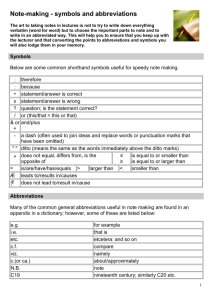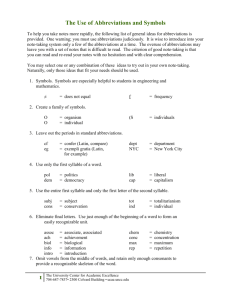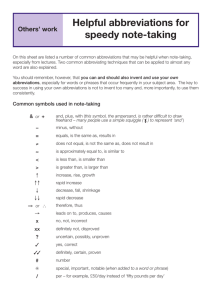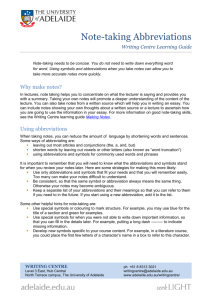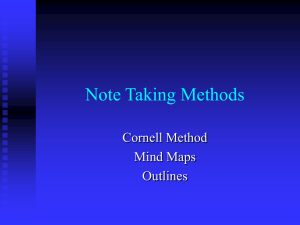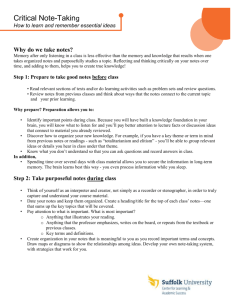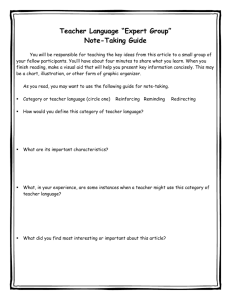CS101 Students and Non-Computer Science Students Log On
advertisement
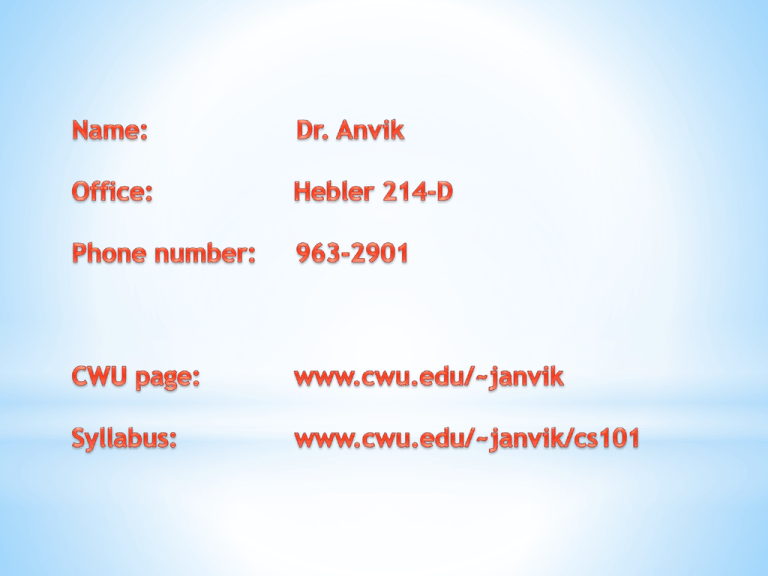
What os note-taking? Note-taking is the practice of recording information captured from another source. By taking notes, the writer records the essence of the information, freeing their mind from having to recall everything. Notes are commonly drawn from a transient source, such as an oral discussion at a meeting, or a lecture (notes of a meeting are usually called minutes), in which case the notes may be the only record of the event. Note taking is a form of selfdiscipline. Ten Basic Steps: 1. Don’t write down everything that you read or hear. Be alert and attentive to the main points. Concentrate on the "meat" of the subject and forget the trimmings. 2. Notes should consist of key words, or very short sentences. As a speaker gets sidetracked you can go back and add further information. 3. Take accurate notes. You should usually use your own words, but try not to change the meaning. If you quote directly from the author, quote correctly. 4. Think a minute about your material before you start making notes. Don’t take notes just to be taking notes! Take notes that will be of real value to you when you look over them later. 5. Have a uniform system of punctuation and abbreviation that will make sense to you. Use a skeleton outline, and show importance by indenting. Leave lots of white space for later additions. 6. Omit descriptions and full explanations. Keep your notes short and to the point. Condense your material so you can grasp it rapidly. 7. Don’t worry about missing a point. Leave space and try to pick up the material you miss at a later date, either through reading, questioning, or common sense. 8. Don’t keep notes on oddly shaped pieces of paper. Keep notes in order and in one place. 9. Shortly after making your notes, go back and rework (not recopy!) your notes by adding extra points, spelling out unclear items, etc.. Remember, we forget quickly. Budget time for this vital step just as you do for the class itself. 10. Review your notes periodically. This is the only way to achieve lasting memory. 1. Use dashes for words when the speaker goes too fast. Leave space so that you can fill in details later. 2. Use symbols to call attention to important words: underline, CAPS, circle, box, *, !, ?, or › . 3. When the instructor says, "this is important" get it exactly and * (mark it). Get a reference to the text or other source if you can. 4. Don’t erase a mistake and don’t black it out completely. Draw a single line through it. This saves time and you may discover later that you want the mistake. 5. Abbreviate – Shortcuts, such as abbreviations, are alternatives to writing everything longhand. Abbreviate only if you will be able to understand your own symbols when you go back to study your notes. Be constantly on the lookout for new and useful abbreviations and symbols to shorten your writing time. This will also increase your listening time. Commonly Used Symbols and Abbreviations: *From "*How to Succeed in College“ by Gerow & Lyng and "Study Skills: A Student’s Guide for Survival" by Carman & Adams, Jr. & and No. or # number = equal to, is the same as b/4 before ref. reference w/ with > greater than < less than i.e., that is vs. versus, as opposed to e.g., for example etc. et cetera Q. question b/c because w/o without Any other suggestions? Outline Style Outlines work particularly well when the material being presented is well organize and when the information moves from main ideas to support detail. In an outline style of note taking, each point being recorded is separately numbered or lettered. Phrase Style When the manner in which the lecture is presented approaches a situation much like storytelling, jotting down phrases may be the best technique for note taking. Vocabulary Style Many courses (particularly at the introductory level) deal exclusively with the development of new vocabulary. As you take notes, one of your main objectives is to list the new vocabulary items and to spell them correctly. Although your may just list the words and definitions in your notes, these terms will have to be integrated with textbook notes and other materials. You need to have these definitions handy so you can formulate questions about concepts involving these words. Drawing, Graph, and Problem Style In many of your classes, your notes will be essentially non-verbal. Some obvious examples include diagrams, mathematical formulas/problems, drawings, and all sorts of charts and graphs. These pictorial representations are most important because they condense and summarize information that is difficult to write out. “Learn, compare, collect the facts.” – Ivan Petrovic Pavlov (1849 – 1936), Russian physiologist. Fine-tune the structure and organization of your notes to increase your note-taking speed and comprehension later: Start each new lecture on a new page, and date and number each page. The sequence of material is important. Write on one side of the paper only. You can set them out side-by-side for easier reviewing when studying for an exam. Leave blank spaces. This allows you to add comments or note questions later. Make your notes as brief as possible. “Never use a sentence when you can use a phrase, or a phrase when you can use a word” (Berkeley). Develop a system of abbreviations and symbols you can use wherever possible. Note all unfamiliar vocabulary or concepts you don’t understand. This reminds you to look them up later. For examples of popular note-taking formats, see “NoteTakingSystems “ “There is a great difference between knowing a thing and understanding it.” – Charles Kettering (1876 – 1958), American electrical engineer and inventor Knowing what and how much to write down is sometimes difficult. Rely on some of the following tips for what to include in your notes: Details, facts, or explanations that expand or explain the main points that are mentioned. Don’t forget examples. Definitions, word for word. Enumerations or lists of things that are discussed. Material written on the chalkboard or on a transparency, including drawings or charts. Information that is repeated or spelled out. “Ideas won’t keep; something must be done about them.” – Alfred North Whitehead (1861 – 1947), English mathematician and philosopher Academic skills centers and other authorities on effective study skills consider reviewing and editing class notes to be the most important part of note-taking and essential to increasing learning capacity: It is extremely important to review your notes within 24 hours. Edit for words and phrases that are illegible or don’t make sense. Write out abbreviated words that might be unclear later. Edit with a different colored pen to distinguish between what you wrote in class and what you filled in later. Fill in key words and questions in the left-hand column. Note anything you don’t understand by underlining or highlighting to remind you to ask the instructor. Compare your notes with the textbook reading and fill in important details in the blank spaces you left. Consider rewriting or typing up your notes. An active learning process A system of note taking designed to maximize time and efficiency An organization tool A tool used for study and review Developed by Walter Pauk of Cornell University One of the most commonly used note taking systems Students needed a more effective way to take notes Organized and systematic Allows you to record/review notes Stay actively engaged in material Easy format Saves time and effort Built in feedback 2 columns, approx. 2 ½ in. and 6 in. Notes labeled with topic, date, class, chapter #, etc. Why? Recording of notes from book or lecture done in the larger column NOT word for word Make it simple: use abbreviations, short hand, summaries whenever possible Use headings, numbers, dashes, etc. to divide information and KEEP IT ORGANIZED! Leaves spaces if necessary to fill in later Keep writing! Record only main ideas and important details – be selective When? As soon as possible. Where? In the smaller column. What? Take your right-hand column notes and reduce into key words, phrases, and questions. Why? These will serve as memory cues and aid in your studying. FEEDBACK Practice: Reduce the following piece of information. Numbering ideas in your notes helps you remember how many important points are in each section. Speak out loud Use own words “Self-Explaining” Check for Understanding Use feedback – what needs clarification? to be studied further? What needs “Think or consider seriously” Think about your notes Create summaries Create outlines Create study tools (index cards, maps, drawings, lists, study tapes, etc.) Explain to a study partner Immediately and often! Why? Curve of Forgetting – look at this REDUCE (After lecture) RECORD (During lecture) REDUCE Key words, phrases, or questions (in your own words) RECORD 1. Write down facts, ideas, and phrases 2. Use abbreviations (when possible) 3. Read through your notes (after lecture) 4. Fill in the blanks and make more legible (after lecture) RECITE (out loud, in own words, using reduce column as prompts) REFLECT 1. Questions 2. Summaries 3. Associations) REVIEW 1. Immediately and often Write a summary of your notes here in complete sentences
